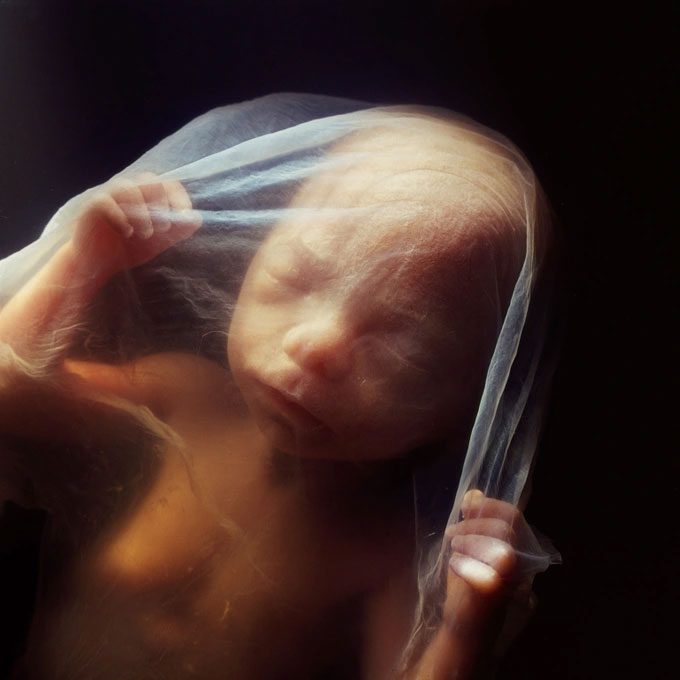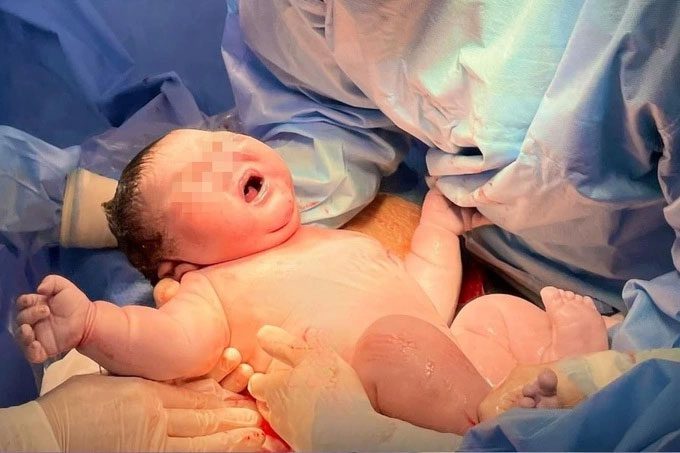The fetus and fish are remarkably similar during the first four weeks following fertilization.
This fluid serves a protective role, allowing the fetus to move and exercise its muscles in an aquatic environment before birth.
Among its functions, the placenta filters nutrients from the mother and supplies oxygen to the fetus through the umbilical cord until delivery. At the same time, the placenta plays a crucial role in eliminating waste and toxins.
Why does the fetus breathe without using its lungs?
Fish and humans share significant similarities around four weeks post-fertilization. In fish, the folded structures develop into fleshy filaments known as gills, which are filled with blood vessels that extract oxygen from water while releasing carbon dioxide (CO2).

Inside the womb, the fetus floats in a clear, slightly yellow fluid. (Illustration: National Geographic).
In contrast, similar folded structures in humans develop into our jaws.
By the fourth to fifth week of pregnancy, the fetal respiratory system begins to form and the lungs start to develop.
By the end of the eighth week, the basic structure of the lungs is gradually completed. In the following weeks, lung tissue continues to grow and mature.
By the time of full-term pregnancy, the fetus’s lungs are fully developed and nearly ready to inhale and exhale the moment the baby is born.
However, while in the womb, the fetus’s lungs are filled with fluid. This fluid is secreted by the fetus itself to provide cushioning and protect the developing organs, preventing compression and avoiding damage.
Oxygen from the mother’s blood is transferred through the placenta into the fetus’s blood, while carbon dioxide and other waste from the fetus are expelled through the placenta back into the mother’s blood.
This process is known as placental respiration, allowing the fetus to obtain the necessary oxygen for metabolism without using its own lungs.
Oxygen-rich blood from the placenta is distributed to the developing organs and tissues through the umbilical arteries, while deoxygenated blood returns to the placenta via the umbilical vein.
Throughout the development in the womb, the fetus relies entirely on the placenta to provide nutrients and oxygen. Since their lungs are filled with fluid, they are inactive and will be activated mere seconds after the baby is born.
How does a baby begin to breathe air through its lungs?
The fetus begins to perform some breathing motions around 10 to 12 weeks and progressively increases these movements as the mother approaches 40 weeks of pregnancy. This helps the fetus train its respiratory muscles, develop its lungs, and establish the nerve pathways that control breathing in preparation for activation when the baby is born.

Newborn babies are stimulated by doctors to cry, initiating the respiratory process of their lungs. (Illustration: Hoàng Lê).
During the delivery process, the pressure will expel some of the fluid from the lungs.
Additionally, the pressure changes during delivery and hormones in the baby’s body help absorb the lung fluid.
When the baby is born, the sudden temperature drop from the womb to the outside world will trigger various physical responses in the body; cold air and light are factors that activate the baby’s lung respiration process.
Dr. Tingay from the Royal Children’s Hospital in Melbourne (Australia) explains: “The fetus’s lungs function like a large sponge, filled with fluid and little space for air.”
The pressure from the airflow during the baby’s first breath will expel any remaining fluid from the lungs.
This also explains why doctors stimulate newborns to cry immediately after birth.
Dr. Fernandes from Baylor College of Medicine (USA) adds: “When a baby is born, we want them to cry as much as possible because it helps open the lungs very effectively.”
As the lungs expand, air fills the spaces, and other organs absorb any remaining fluid in the lungs.
Along with this, neural stimuli will activate the newborn’s breathing and certain genes shortly after birth.
Notably, in cesarean deliveries, the labor process may not begin naturally, which can hinder the absorption of lung fluid.
This leads to some babies potentially retaining fluid in their lungs and encountering respiratory issues after birth.
However, this issue occurs more frequently in premature infants, as they not only have fluid retention in their lungs but also may have underdeveloped lungs.
For this reason, some neonatal doctors advise against elective cesarean procedures unless medically indicated.
By taking that first big breath, the baby breaks free from the dependence on the womb and placenta, transitioning out of the aquatic world inside the mother.
This moment is akin to a declaration of independence for the child, marking the beginning of their breathing in the outside air.


















































